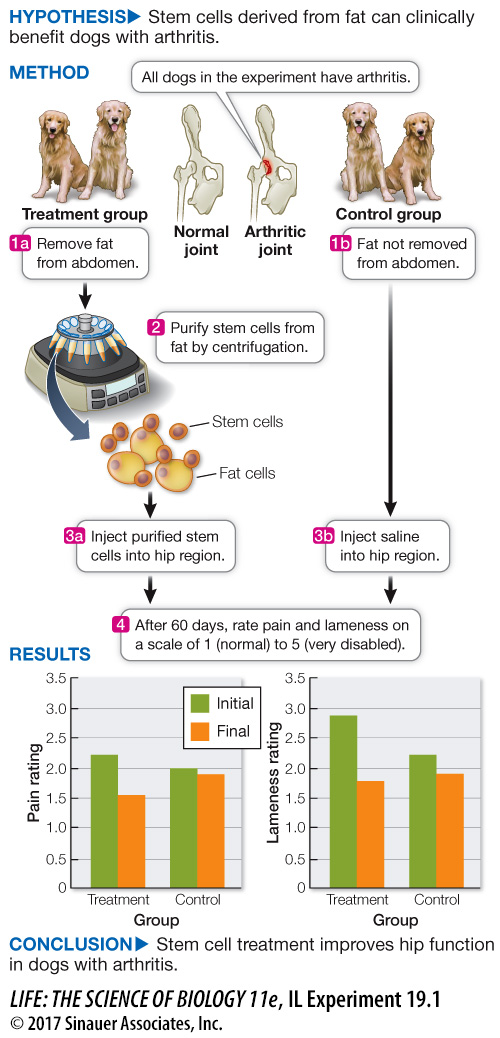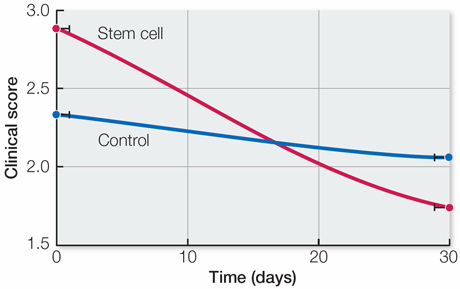Multipotent stem cells differentiate in response to environmental signals
As you learned in the opening story, stem cells are rapidly dividing, undifferentiated cells that can differentiate into diverse cell types. In plants, stem cells occur in the meristems (see Key Concept 33.1). In mammals, stem cells are found in adult tissues that need frequent cell replacement, such as the skin, the inner lining of the intestine, and the bone marrow, where blood cells and other types of cells are formed.
The stem cells found in adult animals are not totipotent, because their ability to differentiate is limited to a relatively few cell types. In other words, they are multipotent. For example, there are two types of multipotent stem cells in the bone marrow. Hematopoietic stem cells produce red and white blood cells, whereas mesenchymal stem cells (like those used to treat the dog Ruby in the opening story) produce bone and connective tissues, including muscle.
404
investigating life
Stem Cell Therapy
experiment
Original Paper: Black, L. L., J. Gaynor, D. Gahring and C. Adams. 2007. Effect of adipose-
Arthritis causes significant disability in dogs, especially older ones. In the United States, more than 10 million dogs suffer from arthritis at some point in their lives. A major reason for arthritis at joints is a breakdown of cartilage tissue that acts as a lubricant between the bones. Without it, there is pain and lameness. While working at a biopharmaceutical company serving veterinarians, Linda Black coordinated a study to determine whether multipotent stem cells contained within fat tissue could, in the right environment, make cartilage that would relieve pain and mobility problems in arthritic dogs.

work with the data
The experiment was conducted as a randomized, double-
| Condition | Treatment | Initial | 60 days later |
|---|---|---|---|
| Lameness | Stem cell | 2.89 (0.20) | 1.78 (0.32) |
| Control | 2.22 (0.15) | 1.89 (0.31) | |
| Pain | Stem cell | 2.22 (0.15) | 1.56 (0.18) |
| Control | 2.00 (0.17) | 1.89 (0.20) | |
| Motion | Stem cell | 2.89 (0.20) | 1.89 (0.26) |
| Control | 2.33 (0.17) | 2.11 (0.20) |
QUESTIONS
Question 1
Why is the RCT considered the “gold standard” for clinical research?
In an RCT, the only difference between treated and untreated subjects is the response to the variable under investigation. Genetic and other differences between experimental and control groups are assumed to be randomized and equal between the groups.
Question 2
How did researchers reach the conclusion that the stem cell treatment given to the dogs in the experimental group was effective? What statistical test would you use to evaluate the significance of any differences between the initial and the final observations in Table A (see Appendix B)?
The difference in the score for lameness in the stem cell group at 60 days was –1.11. This is greater than the difference in the experimental group (–0.33). So there was more improvement in the stem cell group. A statistical test to show the significance of the differences would be the t-
Question 3
To determine the time course of any changes in clinical status, dogs were examined at various time periods after injection. The scores for range of motion are reported in Table B. Plot these data as percent change in clinical score versus time. What can you conclude about the time course of the effect of stem cells?
| Time (days) | Stem cell group | Control group |
|---|---|---|
| Initial | 2.89 | 2.33 |
| 30 | 1.73 | 2.05 |
| 60 | 1.89 | 2.11 |
| 90 | 1.85 | 2.30 |
Plot with Excel. The beneficial effect of stem cell treatment was evident after 30 days.

A similar work with the data exercise may be assigned in LaunchPad.
405
Multipotent stem cells proliferate and differentiate “on demand” in response to environmental signals. For example, hematopoietic stem cells proliferate in the bone marrow in response to growth factors, and the extra stem cells are released into the blood. An important therapy called hematopoietic stem cell transplantation helps replace cells damaged in some kinds of cancer treatment. Stem cells can be harvested from the bone marrow or blood of the patient (prior to cancer treatment) or of a donor, and then the cells are injected back into the patient after cancer treatment.
Signals from adjacent cells can stimulate stem cell differentiation. Many controlled experiments have shown that damaged animal tissues (for example, hearts and tendons) that are injected with stem cells can heal more effectively than tissues that don’t receive this treatment. As mentioned in the opening story of this chapter, therapy for degeneration of joints due to age or injury is now a well-
How stem cells work after injection is not clear. They may actually insert themselves into the damaged tissue and differentiate into new cells of that tissue. Alternatively, injected cells may secrete growth factors and other molecules that induce the cells in the surrounding tissue to regenerate into healthy tissue. Whatever the mechanisms by which multipotent stem cells contribute to the healing of damaged tissues, their use in treating diseases is very promising.